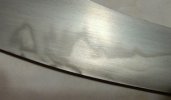- Joined
- Feb 4, 1999
- Messages
- 5,786
I got the picture below from Fogg's forum. I circled a couple things of his hamon (these "wisps" in the hamon are ashi, no?). My question is how do you get these? This is the activity that is missing from my hamon. What I want to know is this: do these "wisps" form under the clay "stripes" that Engath describes as being the first step in his clay coating procedure? He describes using a palette knife or something along those lines, getting a bit of Satanite on it, and smacking the side of the blade to transfer it like a line of goop to the side of the blade. After doing that at regular intervals, then he puts a thicker coating toward the middle/spine of the blade of clay.
So, do these wisps come from that, or what? This is the only thing, other than forging, that I do not do on my blades, and I don't see these wisps in my hamon, so is that why?
So, do these wisps come from that, or what? This is the only thing, other than forging, that I do not do on my blades, and I don't see these wisps in my hamon, so is that why?



